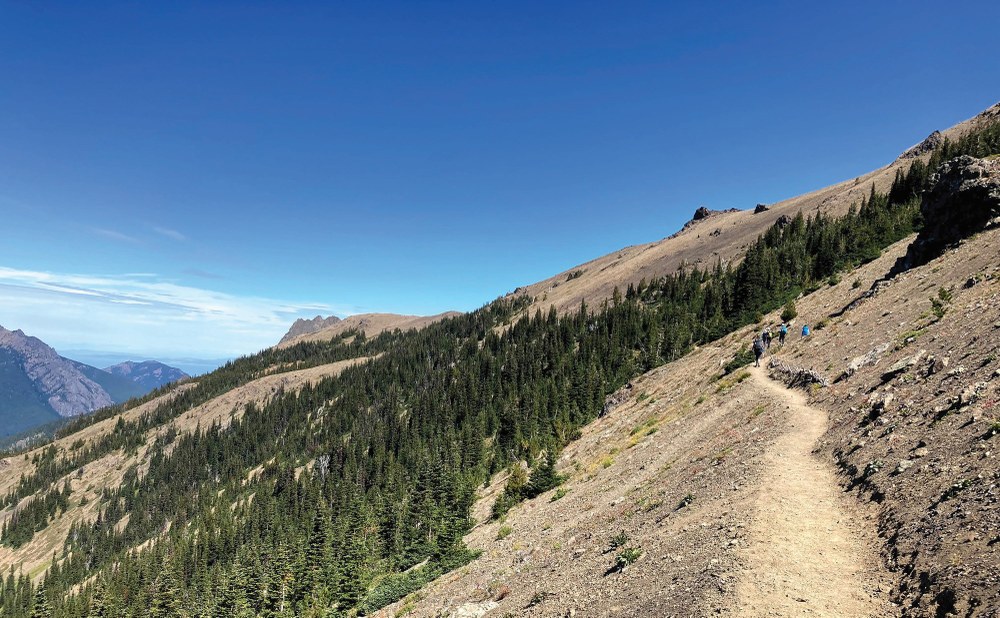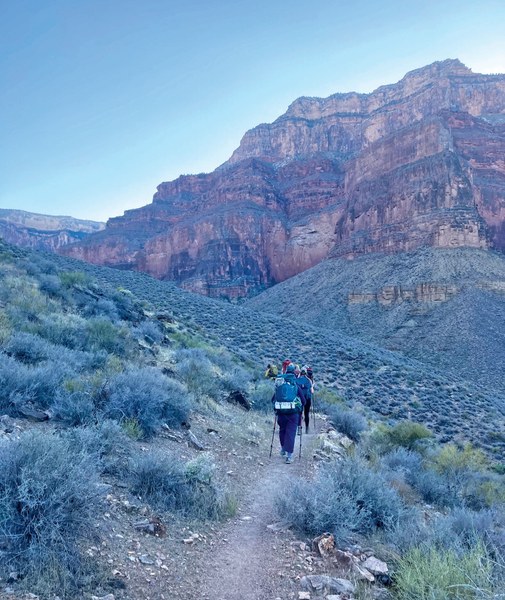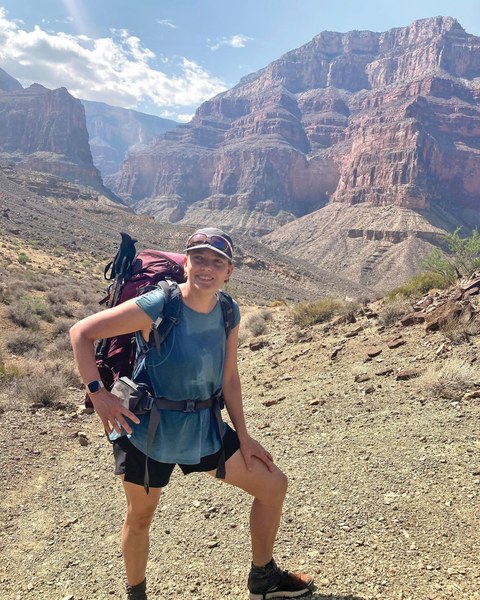
Craggy, striated spires glowed pink in the evening light as I gazed up from the bottom of the Grand Canyon. I was on a four-day backpacking trip that had been on my wish list for years. After being cooped up for most of 2020 due to the pandemic, I found myself staring in surprise at the expanse around me, so much vaster in person than on flimsy postcards.
I’d spent almost every weekend that summer training for my backpacking trip, relieved to once again feel the freedom of miles unfurling beneath my lightweight hikers. My legs took me on steep, snow-covered conditioning hikes in the spring, then sunny, wildflower-dotted ridgelines and brushy-meadowed ambles as the weather warmed. I lugged a 30-pound pack up Poo Poo Point, then Mt. Si the following month, and finally Mailbox Peak. After each hike, I’d return home with pine needles in my shoes, dirt under my fingernails, and the deep satisfaction of reaching a goal that was part of a larger plan.
Reaching the bottom of the Grand Canyon was as magical as I’d hoped. Cloud shadows drifted across sagebrush flats while the scarred walls of the canyon rose up around us, echoing the ancient presence of time, wind, and water. After several days learning about the cultural and geological history of the canyon, exploring cool slot canyons, and sleeping under a full moon beside the rushing Colorado River, we climbed back out the steep, rocky trail onto a flat, paved road.
And then… the trip was over. I returned home to the flow of daily life without the larger goals that had inspired me that summer. As the days turned colder and shorter, I hiked less frequently. I could feel myself losing the training edge I’d worked so hard for. Feeling disappointed, disoriented, and sad at times, I fumbled around online trying to figure out my next adventure.
I had a case of the post-trail blues.
 On the Hermit Loop Trail, Grand Canyon National Park. Photo by Jessica Hirst.
On the Hermit Loop Trail, Grand Canyon National Park. Photo by Jessica Hirst.
What are the post-trail blues?
The term "post-trail blues" is often used by long-distance and thru-hikers to describe the state of mind experienced after completing a momentous trip like the Pacific Crest Trail or Appalachian Trail, but post-trail blues can be experienced by anyone who has completed an adventure that feels significant.
After spending long hours gaining the tops of ridgelines, feeling the endorphin rush of physical effort, breathing fresh air, and sleeping under the stars every night, readjusting to normal life can be hard. Hikers experiencing post-trail blues might feel a combination of fatigue, listlessness, nostalgia, sadness, anxiety, or even depression due to the following factors:
End of a routine. Multi-day hikes create a daily routine and a clear sense of purpose. Finishing the trail can leave hikers feeling aimless, without the structure they had during their adventure.
Loss of community. Many long-distance hikers and adventurers form strong bonds with others, especially if a trip occurs over weeks or months. Completing the trail might mean leaving behind a close-knit community, which can lead to feelings of isolation.
Shift in environment. Transitioning from the natural, often peaceful environment of the trail to the busy, sometimes stressful environment of everyday life can be jarring.
Achievement letdown. Accomplishing the significant goal of a challenging adventure can leave hikers wondering what’s next.
Physical and mental adjustment. The body and mind might take time to adjust from the physical exertion and mental focus required on the trail to the different and comparatively sedentary demands of daily life.
 Jessica on the way to the base of the Grand Canyon. Photo courtesy of Jessica Hirst.
Jessica on the way to the base of the Grand Canyon. Photo courtesy of Jessica Hirst.
How to cope with the transition
If you’re experiencing a rough return after the end of an adventure, here are tips from my own experience on how to manage the blues.
Find new goals, but don’t go too crazy
Setting new goals can help maintain a sense of purpose, as long as the goals fit realistically into your lifestyle. Having something to look forward to can help redirect your focus and energy. That said, I don’t recommend overscheduling yourself by signing up for too many outdoors-oriented workshops and courses. I learned this the hard way. My initial excitement about having structured goals again after the Grand Canyon quickly turned to panic in November as the busy holiday season set in.
What ultimately helped my transition the most was leaning into daily life with its joys, pleasures, accomplishments, and comforts. Unless I make a radical lifestyle change and become a full-time adventurer, venturing out and returning home will always be a rhythm in my life, even if the transition is sometimes rocky.
I eventually dropped some of the workshops I had signed up for and settled into a weekend routine of snowy training hikes, reading on the couch as rain spattered the windows, and planning my spring garden. I also signed up for the Backpacking Building Blocks course, which gave me something to look forward to that I knew I’d have time for.
Maintain connections
Staying in touch with your trail community can also help. If you’ve formed important connections with others during your adventure, continue reaching out, even if life feels busy. Consider joining in-person or virtual Mountaineers groups focused on the type of adventure you’ve completed. These groups can be spaces to share experiences and trail memories with people who understand the unique challenges and triumphs of your trip. In my experience, family members are only so interested in hearing about that time your boot sole came loose and had to be secured with duct tape, whereas swapping trail stories with other adventurers can be entertaining for much longer.
Stay active, even in a smaller capacity
Even if smaller physical goals don’t feel as compelling after a big adventure, staying active is important. Maintaining your fitness by sticking to a regular routine can improve your mood and keep you in shape for the next big adventure that might be just around the corner.
The winter after my epic Grand Canyon trekking summer, I kept hiking (even though it was at a slower rate and wasn’t as fun without a bucket-list goal to work toward). But continuing to hike kept me in good enough shape to enjoy the Backpacking Building Blocks course, which then led to new adventures in places like the Olympics and the Enchantments.
The way I see it now, adventures might end, but they shape you in ways that remain. Next time you experience a case of post-trail blues, remember: your trip left you with insights and resilience for the next endeavor. My Grand Canyon trekking summer may be long over, but the impact it had on my character remains, perhaps not unlike the way water and weather continue to leave their mark on the sandstone and shale of the Grand Canyon.
This article originally appeared in our fall 2024 issue of Mountaineer magazine. To view the original article in magazine form and read more stories from our publication, visit our magazine archive.
 Jessica Hirst
Jessica Hirst